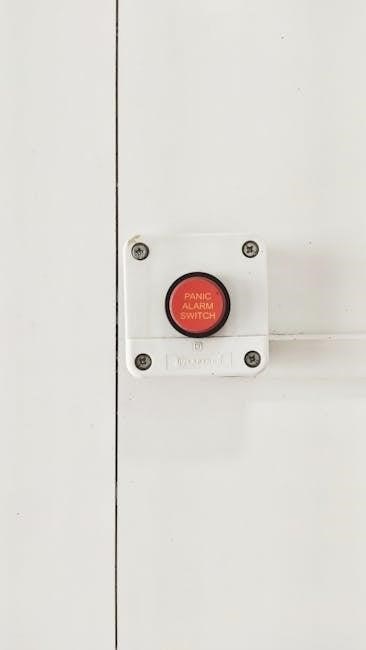The PowerFlex 755 AC drives offer versatile motor control, integration ease, and high performance, designed to increase productivity across various industries. They provide application flexibility, energy efficiency, and a wide power range, making them suitable for manufacturing, food and beverage, water/wastewater, and other high-demand sectors.
1.1 Overview of PowerFlex 755 Series
The PowerFlex 755 Series is a high-performance AC drive designed for versatile motor control and seamless integration across various industrial applications. With a power range from 7.5 to 250 kW, it offers flexibility, energy efficiency, and advanced control capabilities. This series supports multiple voltage options and includes a common DC bus for energy savings. Its robust design and adaptability make it suitable for industries like manufacturing, food and beverage, water/wastewater, and automotive, ensuring reliable operation and increased productivity.
1.2 Key Features and Benefits
The PowerFlex 755 Series offers advanced motor control, high performance, and energy-saving capabilities. Its key features include a wide power range, multiple voltage options, and a common DC bus for energy efficiency. It provides seamless integration with Rockwell Automation systems, customizable control algorithms, and robust safety functions. Benefits include increased productivity, reduced energy costs, and enhanced machine uptime. The drive is designed for versatility, making it suitable for high-demand applications across various industries, ensuring reliable and efficient operation.
1.3 Target Industries and Applications
The PowerFlex 755 AC drives are ideal for various industries requiring high-performance motor control. They are widely used in manufacturing, food and beverage, water/wastewater treatment, materials handling, metals, mining, and automotive sectors. These drives are suitable for applications needing precise speed control, energy efficiency, and reliability. Their versatility makes them a preferred choice for demanding environments where productivity and operational efficiency are critical. The PowerFlex 755 Series supports a range of applications, ensuring optimal performance and adaptability to specific industry needs.

System Requirements and Compatibility
The PowerFlex 755 AC drives are compatible with a wide range of AC motors and support multiple voltage options, including 240V, 400V, and 600V systems.
2.1 Power Range and Voltage Options
The PowerFlex 755 AC drives are available in a wide power range, from 0.25 to 1500 horsepower (0.18 to 1120 kW), catering to various industrial applications. Voltage options include 240V, 400V, and 600V, ensuring compatibility with different power systems. The drives support both single-phase and three-phase AC input, offering flexibility for installation; Environmental considerations include operating temperatures up to 50°C and humidity up to 95% non-condensing. The IP20-rated enclosure provides protection against solid particles and liquids. Compliance with UL and IEC standards ensures global suitability and safety.
2.2 Motor Compatibility and Control Modes
The PowerFlex 755 drives are designed to work with a variety of AC motors, including induction and synchronous motors. They support multiple control modes, such as V/Hz control, sensorless vector control, and flux observer control, ensuring precise speed and torque regulation. These modes cater to different motor types and application requirements, providing flexibility for industrial automation. The drives also offer compatibility with permanent magnet motors, enhancing energy efficiency in demanding applications. This versatility makes them suitable for a wide range of industrial processes and machinery.
2.3 Communication and Network Integration

The PowerFlex 755 AC drives support a wide range of industrial communication protocols, including EtherNet/IP, Modbus TCP/IP, and Profinet, enabling seamless integration with modern control systems. The drives can also be equipped with optional communication modules for added flexibility. This capability allows for real-time data exchange, remote monitoring, and precise motor control. The built-in Ethernet port and compatibility with DeviceNet and ControlNet further enhance connectivity, ensuring efficient communication across industrial networks and supporting advanced automation solutions.

Pre-Installation Considerations
Ensure proper site evaluation, safety compliance, and preparation of tools and materials before installing the PowerFlex 755 drive to guarantee a smooth and safe installation process.
3.1 Site Preparation and Environmental Factors
Ensure the installation site provides a stable, clean, and dry environment for the PowerFlex 755 drive. The location should maintain a temperature range of 0°C to 55°C and humidity below 95% non-condensing. Proper ventilation is essential to prevent overheating. The drive should be mounted on a sturdy, vibration-free surface, and the area must be clear of conductive dust or corrosive substances. Ensure proximity to a reliable power supply and grounding system to meet electrical safety standards. Adhere to local environmental regulations during preparation.
3.2 Safety Precautions and Compliance
Always wear personal protective equipment, including safety glasses and insulated gloves, when handling the PowerFlex 755 drive. Ensure the power supply is disconnected before starting installation. Follow proper lockout/tagout procedures to prevent accidental startups. Adhere to local and international safety standards, such as NFPA 79, for electrical equipment installation. Properly ground the drive to prevent electric shock. Use approved components and tools to maintain compliance with safety regulations. Refer to the official manual and local codes for specific requirements to ensure a safe installation environment.

3.3 Tools and Equipment Needed
The installation of the PowerFlex 755 drive requires specific tools and equipment to ensure proper setup. Essential items include a multimeter, screwdrivers (flathead and Phillips), torque wrench, and wire strippers. For programming, an RSLogix or Studio 5000 software-compatible device is necessary. Additional tools may include a ladder or lifting equipment for mounting, network cables for communication modules, and insulated hand tools for electrical connections. Always use tools rated for the drive’s voltage and current specifications to avoid damage or injury. Proper equipment ensures a safe and efficient installation process.

Installation Steps
The installation process includes unpacking, inspecting, securely mounting the drive, connecting wiring and power supply, attaching the motor, and installing communication modules if required. Testing ensures functionality.
4.1 Unpacking and Inventory of Components
Carefully unpack the PowerFlex 755 AC drive and all accessories from the shipping container. Inspect for damage and verify the components against the packing list. Ensure the drive unit, mounting hardware, power cables, and documentation are included. Check for any signs of physical damage or tampering. Organize the components in a clean, dry workspace to ensure efficient installation. If any items are missing or damaged, contact the supplier immediately for replacement before proceeding. Proper inventory ensures a smooth installation process.
4.2 Mounting the Drive and Connecting Wiring
Mount the PowerFlex 755 AC drive on a flat, secure surface using the provided mounting hardware. Ensure the drive is installed in an upright position to maintain proper airflow and heat dissipation. Leave adequate space around the unit for cooling. Connect the input and output wiring according to the terminal labels, ensuring all connections are tight and meet torque specifications. Verify motor and power supply connections align with the drive’s ratings. Double-check all wiring before applying power to prevent electrical hazards. Proper installation ensures reliable operation and safety. Always follow the manufacturer’s wiring diagram for accuracy.
4.3 Power Supply and Motor Connections
Connect the PowerFlex 755 AC drive to a compatible power supply, ensuring the voltage and current ratings match the drive’s specifications. Disconnect the power supply before making any connections to avoid electrical shock. Wire the motor to the drive’s output terminals, following the manufacturer’s recommendations. Secure all connections with the recommended torque to prevent loose wiring. Verify that the motor and power supply connections are correctly aligned with the drive’s ratings. Proper connections are critical for safe and reliable operation. Always refer to the wiring diagram for accuracy. Ensure all connections are tight and meet safety standards. Avoid overloading the drive. Adhere to local electrical codes. Double-check all connections before energizing the system. Use appropriate gauge wires to minimize voltage drop. Ground the drive and motor properly to prevent noise and ensure safety. Keep all wires organized and secured to prevent damage. Regularly inspect connections for signs of wear or overheating. Use protective equipment when handling live circuits. Follow all safety protocols to prevent injury or equipment damage. Ensure the power supply is suitable for the drive’s power requirements. Verify the motor is compatible with the drive’s output. Use the correct cable types for high-frequency PWM outputs. Shielded cables are recommended to reduce electromagnetic interference. Proper shielding ensures reliable communication and prevents noise interference. Always follow the manufacturer’s guidelines for cable selection and installation. Secure all cables to prevent movement during operation. Label all wires clearly for future maintenance. Ensure all connections are accessible for inspection and servicing. Maintain proper clearance between wires and heat-generating components. Avoid routing wires near high-temperature areas. Use cable ties or clips to manage wires neatly. Keep the work area clean and well-ventilated during installation. Dispose of packaging materials responsibly. Follow all local and national electrical codes. Ensure compliance with industry standards for wiring practices. Use only approved tools and materials for connections. Test all connections before applying power. Monitor for any signs of malfunction during initial power-up. Address any issues promptly to prevent damage. Maintain records of connections for future reference. Plan for easy access during maintenance. Ensure all connections are weatherproof if installed in harsh environments. Use appropriate connectors and seals to protect against moisture and contaminants. Regularly inspect connections in harsh environments. Replace any damaged or corroded components immediately. Keep spare wiring and connectors on hand for repairs. Train personnel on proper connection procedures. Develop a maintenance schedule to inspect connections regularly. Use thermal imaging to detect overheating connections. Address any overheating issues promptly to prevent failure. Ensure all connections are secure and meet load requirements. Use locking connectors where applicable. Test all connections under load to ensure reliability. Monitor connections during initial operation to ensure stability. Adjust connections as needed for optimal performance. Document any adjustments for future reference. Ensure all connections comply with safety regulations. Use only certified and approved materials. Follow all safety guidelines when working with electrical systems. Ensure proper grounding to prevent electrical hazards. Test the grounding system before energizing the drive. Use a multimeter to verify all connections are secure and within specifications. Check for any short circuits or open circuits before applying power. Ensure all wires are properly insulated and rated for the application. Use color-coded wires for easy identification. Follow industry best practices for wiring and connections. Ensure all connections are neat and organized for easy troubleshooting. Label all wires and connections clearly for future reference. Keep the installation clean and tidy to prevent accidents. Ensure all connections are accessible for inspection and maintenance. Use only high-quality wires and connectors to ensure reliability. Avoid using damaged or substandard materials. Regularly inspect wires for signs of wear or damage. Replace any damaged wires promptly to prevent failures. Use protective covers or sleeves on wires exposed to moving parts. Ensure all connections are protected from mechanical stress. Use flexible cables where movement is expected. Secure all cables to prevent vibration damage. Properly route cables to avoid pinching or crushing. Use cable management systems to organize wires effectively. Ensure all connections are protected from environmental hazards. Use appropriate shielding for cables in noisy environments. Follow all manufacturer recommendations for cable installation. Ensure all connections are properly documented for future maintenance. Keep a record of all wiring and connections for reference. Train maintenance personnel on connection procedures. Develop a checklist for verifying connections during installation. Ensure all connections are tested and validated before startup. Monitor connections during initial operation to ensure reliability. Address any issues promptly to prevent downtime. Maintain a spare parts inventory for common wiring components. Plan for future upgrades or modifications when installing connections. Ensure all connections are scalable for potential system expansion. Use modular connectors for easy upgrades. Follow all safety protocols when working with live electrical systems. Ensure all connections are de-energized before performing maintenance. Use proper personal protective equipment when handling electrical components. Follow lockout/tagout procedures to ensure safety during maintenance. Ensure all connections are properly labeled and signed for easy identification. Use warning labels to indicate high-voltage areas. Ensure all connections are-insulated and protected from accidental contact. Use safety barriers or guards where necessary. Ensure all connections meet local and national electrical codes. Follow all industry standards for wiring and connections. Use only approved tools and materials for the installation. Ensure all connections are secure and meet torque specifications. Avoid over-tightening connections to prevent damage. Use the correct tools for tightening connectors. Ensure all connections are free from contaminants and debris. Clean all connectors before making connections. Use contact cleaners if necessary to ensure good conductivity. Avoid using excessive force when connecting wires. Ensure all connections are aligned properly before tightening. Use alignment guides or tools if provided. Double-check all connections for proper alignment and security. Ensure all wires are seated fully in their connectors. Verify all connections visually before applying power. Use magnification tools if necessary to inspect connections. Ensure all connections are free from defects or damage. Replace any damaged connectors or wires before use. Use high-quality connectors to ensure reliable connections. Avoid using connectors with worn-out or damaged contacts. Ensure all connectors are rated for the application’s current and voltage. Use only connectors approved by the manufacturer. Follow all manufacturer guidelines for connector installation. Ensure all connections are protected from environmental factors like moisture or dust. Use weatherproof connectors in harsh environments. Apply dielectric grease to connectors in corrosive environments. Ensure all connections are properly sealed to prevent contamination. Use gaskets or O-rings where necessary to maintain a seal. Regularly inspect connectors in harsh environments for signs of wear. Replace any damaged or corroded connectors promptly. Use protective covers or boots on connectors exposed to heavy use. Ensure all connections are labeled clearly for easy identification. Use color-coding or labels to differentiate between different wires. Follow industry standards for wire color-coding. Ensure all labels are durable and legible for the expected environment. Use high-quality labels that can withstand heat, moisture, and chemicals. Apply labels securely to prevent peeling or fading. Ensure all labels are consistent throughout the installation; Use a labeling system that is easy to understand and maintain. Train personnel on the labeling system for easy identification. Ensure all labels are updated whenever changes are made to the system. Keep a master list of all labels and their corresponding wires. Use barcode or RFID labels for easy scanning and identification. Ensure all labels comply with industry standards and regulations. Use labels that are resistant to wear and tear. Ensure all labels are visible and accessible for inspection. Avoid placing labels where they can be easily damaged. Use protective sleeves or covers on labels in harsh environments. Regularly inspect labels for clarity and accuracy. Replace any faded or damaged labels promptly. Use labels that are compatible with the environmental conditions. Ensure all labels are readable under normal operating conditions. Use contrasting colors for labels to improve readability. Ensure all labels are consistent in font size and style throughout the installation. Use large enough fonts to ensure labels are easily readable. Avoid using overly complex or confusing labels. Keep labels simple and concise for easy understanding. Use symbols or icons where appropriate to supplement text labels. Ensure all symbols are standardized and easily recognizable. Follow industry standards for labeling symbols. Use labels that are bilingual or multilingual if necessary. Ensure all labels are accurate and free from errors. Double-check all labels for spelling and grammar before application. Use labels that are resistant to
4.4 Installing Communication Modules (if applicable)
Install communication modules to enable network connectivity for the PowerFlex 755 drive. Power down the drive before starting. Select the appropriate module (e.g., Ethernet, DeviceNet, or Profibus) and align it with the drive’s communication port. Secure the module using the provided screws or clips. Configure the module settings via the drive’s control panel or software. Ensure proper firmware compatibility. Test communication by pinging the drive or checking network status. Refer to the module’s user manual for specific instructions. Verify all connections are secure and properly configured. Power up the drive and test communication functionality. Address any errors promptly. Document the configuration for future reference. Ensure the module is properly grounded and meets safety standards; Use only Rockwell Automation-approved communication modules. Follow all network security guidelines. Regularly update module firmware to maintain compatibility and security. Use a compatible cable for module connections. Label all communication ports clearly. Ensure the module is installed in a dry, cool environment. Avoid exposing modules to extreme temperatures or vibrations. Secure the module firmly to prevent movement during operation. Use protective covers for unused ports. Test communication latency and throughput after installation. Monitor module performance during initial operation. Replace any faulty modules immediately. Keep spare modules available for quick replacements. Train personnel on module installation and configuration. Develop a maintenance schedule for module inspection. Use diagnostic tools to troubleshoot communication issues. Ensure all modules are properly documented in the system’s network diagram. Use network management software to monitor module performance. Ensure all modules are configured with unique IP addresses. Use subnet masks and gateways appropriately. Enable security features to prevent unauthorized access. Regularly back up module configurations. Use redundant modules if high availability is required. Ensure all modules are compatible with the existing network infrastructure. Follow all network protocols and standards. Use quality-of-service settings to prioritize critical traffic. Ensure all modules are synchronized with the system clock. Use NTP servers for accurate timekeeping. Monitor module performance during peak loads. Address any bottlenecks or delays promptly. Ensure all modules are properly licensed and activated. Use only genuine Rockwell Automation software and firmware. Follow all software update procedures carefully. Test modules in a controlled environment before deploying them in production. Use staging servers for module configuration and testing. Ensure all modules are properly documented and approved before installation. Follow all change management processes when updating modules. Use version control for module firmware and configurations. Ensure all modules are compliant with industry standards and regulations. Use only certified and approved communication modules. Follow all safety guidelines when handling modules. Ensure proper electrostatic discharge protection during installation. Use anti-static wrist straps or mats. Handle modules by the edges to prevent damage. Avoid touching sensitive electronic components. Keep modules in their original packaging until installation. Ensure the installation area is clean and free from debris. Use proper tools for module installation. Follow all torque specifications for screws. Avoid over-tightening to prevent damage. Use the correct screwdriver type to prevent stripping screws. Ensure all screws are securely fastened but not overtightened; Verify module alignment before securing. Use alignment guides if provided. Double-check all connections before powering up. Ensure all ports are clean and free from contaminants. Use compressed air to clean ports if necessary. Avoid using liquids or chemicals that could damage the modules. Use only dry, lint-free cloths for cleaning. Inspect modules for any visible damage before installation. Replace any damaged modules immediately. Keep a record of module serial numbers and firmware versions. Use asset management software to track modules. Ensure all modules are properly integrated into the system’s inventory. Develop a plan for module upgrades and replacements. Ensure all modules are compatible with future system updates. Use modular designs to facilitate easy upgrades. Follow all manufacturer guidelines for module installation and maintenance. Ensure all modules are properly documented in the system’s technical manuals. Use clear and concise labeling for all modules and ports. Ensure all labels are consistent throughout the system. Use color-coding or other methods to differentiate between modules. Follow industry standards for labeling and documentation. Ensure all modules are easily accessible for maintenance and repairs. Use proper lifting techniques when handling modules. Ensure the work area is well-ventilated and free from hazards. Follow all safety protocols when working with electrical components. Ensure all modules are properly grounded to prevent electrical shock. Use surge protectors or uninterruptible power supplies if necessary. Ensure all modules are protected from power spikes and fluctuations. Use high-quality power supplies that meet the module’s specifications. Follow all power safety guidelines when installing modules. Ensure all modules are installed in compliance with local and national electrical codes. Use only approved tools and materials for installation. Ensure all modules are properly tested and validated before being put into service. Monitor module performance closely during the initial operational period. Address any issues promptly to prevent downtime. Maintain a record of module performance and maintenance activities. Use predictive maintenance tools to monitor module health. Ensure all modules are replaced before reaching their end-of-life. Use manufacturer-recommended replacement schedules. Keep spare modules on hand to minimize downtime during replacements. Train personnel on module replacement procedures. Develop a contingency plan for module failures. Ensure all modules are properly disposed of according to environmental regulations. Use eco-friendly disposal methods whenever possible. Ensure all modules are securely stored when not in use. Use protective cases or packaging to prevent damage during storage or transport. Label all stored modules clearly for easy identification. Keep an inventory of all modules, including their locations and statuses; Use barcodes or RFID tags for efficient tracking. Develop a system for tracking module usage and maintenance history. Ensure all modules are calibrated and configured correctly before use. Use calibration tools and software as recommended by the manufacturer. Follow all calibration procedures carefully to ensure accuracy. Verify module calibration by comparing it with known standards. Document all calibration results for future reference. Ensure all modules are functioning within specified tolerances. Address any calibration errors promptly. Use only certified calibration equipment. Follow all manufacturer guidelines for calibration and configuration. Ensure all modules are properly integrated with the system’s control logic. Use programming software to configure module settings. Test all configurations thoroughly before deploying them. Ensure all modules are compatible with the system’s control program. Use only approved software versions for module configuration. Follow all programming standards and best practices. Ensure all modules are properly documented in the system’s program. Use clear and concise comments for easy understanding. Ensure all modules are tested under various operating conditions. Monitor module performance during different load scenarios. Address any performance issues promptly. Use diagnostic tools to identify and resolve module-related problems. Ensure all modules are updated with the latest software patches and security updates. Follow all cybersecurity guidelines when configuring modules. Use strong passwords and authentication methods. Enable encryption for sensitive data transmitted by modules. Regularly audit module configurations for security vulnerabilities. Ensure all modules are compliant with industry security standards. Use only trusted and verified software sources. Follow all change management processes when updating module configurations. Use version control to track changes in module settings. Ensure all modules are properly backed up before making any changes. Use redundant systems to ensure continuity in case of module failures. Develop a disaster recovery plan that includes module replacement and reconfiguration. Ensure all modules are properly integrated with backup systems. Use failover mechanisms to minimize downtime during module failures. Ensure all modules are tested regularly for redundancy and failover functionality. Use monitoring tools to track module performance and redundancy status. Address any redundancy issues promptly to maintain system availability. Ensure all modules are properly synchronized in redundant configurations. Use heartbeat signals or other monitoring methods to ensure module health. Follow all manufacturer recommendations for redundant module installations. Use only compatible modules for redundancy to ensure seamless failover. Ensure all modules are configured identically in redundant setups. Use automated synchronization tools to maintain consistency between modules. Monitor synchronization status regularly to prevent configuration drift. Address any synchronization errors promptly. Use logging tools to track module activity and errors. Analyze logs regularly to identify potential issues before they occur. Ensure all modules are properly sized for the application’s requirements. Use modules with adequate bandwidth and processing power. Avoid overloading modules with excessive data or tasks. Ensure all modules are operating within their specified temperature ranges. Use cooling systems as needed to maintain optimal temperatures. Monitor module temperatures regularly to prevent overheating. Use thermal monitoring tools to track module health. Ensure all modules are installed in well-ventilated areas. Avoid installing modules in enclosed spaces without proper cooling. Use fans or air conditioning to maintain a stable temperature. Ensure all modules are protected from humidity and moisture. Use dehumidifiers or air dryers in humid environments. Ensure all modules are installed on stable and level surfaces. Use anti-vibration mounts if necessary to

Configuration and Setup

Configure the PowerFlex 755 drive by setting parameters, motor data, and communication settings. Use the drive’s control panel or software tools for precise setup and integration.
5.1 Initial Parameter Configuration
Begin by setting essential parameters such as motor ID, speed reference, and control mode. Use the drive’s keypad or software tools to input values. Ensure correct motor data, including ratings and torque requirements. Select the appropriate control mode (V/Hz, sensorless vector, or direct torque control). Configure safety settings and enable/disable advanced features as needed. Save all changes to ensure proper operation. Always refer to the manual for default settings and guidelines to avoid configuration errors.
5.2 Setting Up Motor Parameters
Enter motor nameplate data, such as voltage, power rating, and frequency. Select the motor control mode (V/Hz, vector, or direct torque). Adjust motor parameters like flux and torque for optimal performance. Ensure motor speed and torque limits match application requirements. Use the drive’s software to input and verify settings. Save configurations to prevent loss. Test motor operation at reduced speed to confirm accuracy. Refer to the manual for specific motor parameter guidelines to ensure compatibility and precise control. Proper setup ensures efficient motor-drive interaction and prevents operational issues.
5.3 Configuring Communication Settings
Configure communication settings by selecting the protocol (e.g., Ethernet/IP, Modbus TCP/IP, or DeviceNet). Assign the device ID, baud rate, and parity settings as required by your network. Use the drive’s software to set IP addresses and subnet masks for Ethernet-based communication. Ensure proper configuration of master/slave relationships in fieldbus systems. Verify communication parameters match the connected devices. Test communication links to confirm data transmission accuracy. Refer to the manual for specific protocol guidelines and troubleshooting tips. Proper configuration ensures seamless integration with control systems and devices.
5.4 Testing and Validation
After configuring the drive, perform thorough testing to validate functionality. Run the motor and monitor its performance under various loads. Verify that all configured parameters, including speed, torque, and communication settings, operate as expected. Use diagnostic tools to check for errors or mismatches. Ensure safety features and emergency stop functions work correctly. Review operational data and adjust settings if necessary. Document test results for future reference and ensure compliance with application requirements. Successful validation confirms the drive is ready for full operational use. Proper testing minimizes downtime and ensures reliable performance. Always follow safety protocols during testing.

Advanced Features and Customization
The PowerFlex 755 offers advanced customization options, including energy-saving modes, programmable logic, and seamless integration with Rockwell Automation systems for enhanced control and efficiency.

Appendix
6.1 Energy-Saving Features and Efficiency
The PowerFlex 755 AC drives incorporate advanced energy-saving features, optimizing motor performance and reducing energy consumption. These include adaptive flux vector control and energy-efficient algorithms that adjust motor speed based on load demand. The drives also support regenerative energy solutions, returning excess energy to the power supply. These features not only enhance operational efficiency but also contribute to environmental sustainability by lowering overall energy usage and reducing carbon footprint in industrial applications. Proper configuration ensures maximum energy savings while maintaining high performance levels.
